

I also have a couple of SLR camera lenses that I find very useful, and a X2 teleadaptor that I use extensively in place of a barlow. And I have a X3 barlow, which I don't use very much at all, and a X5 Powermate which is really much too powerful for an f/10 telescope. Used on my LX200 Jupiter fills the chip on my Toucam.1. My Telescopes.
I have five astronomical telescopes.
(1) An old 3.5-inch refractor,
(2) a Meade EXT125 Schmidt-Maksutov,
(3) a Meade 10-inch LX200 Classic Schmidt-Cassegrain.
(4) a Sky-Watcher ST80 Refractor.
(5) a Revelation 8-inch Ritchey-Chrétien.
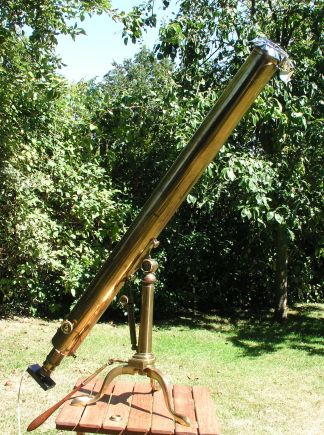
This is my first telescope. It is a 3.5-inch (89 mm) achromatic refractor given to me when I was a
teenager. It has a focal length of 55 inches (1400 mm) and came with 6 eyepieces giving magnifications
ranging from 30 to 230. I used it a lot as a boy looking mostly at the Moon, Jupiter, and Saturn.
I also took pictures of the Sun by projecting an image onto my bedroom ceiling. Around 1971 I made
an adaptor so that I could mount my 35 mm SLR camera on it and got a picture of the Moon for each
day of a lunar cycle, sadly with one missing. I still have them but they have not survived the time well.
The mount is called a "claw and pillar stand" and was described by Patrick Moore as a "blancmange
stand"; a very good description. Generally it has to stand on something. Here it is standing on a small
picnic table which didn't make it any steadier.
More recently I tried it with my ToUcam 740 and was pleasantly surprised by the images I got.
Here you see it imaging the Sun. My unmodified ToUcam is attached at the bottom. At the top
is a solar filter by Heath Robinson. The handle attached to the base is a slow-motion azimuth drive;
unfortunately the altitude drive is much more crude. The trick is to image when the object is due south.
You can see some pictures taken through this telescope here.
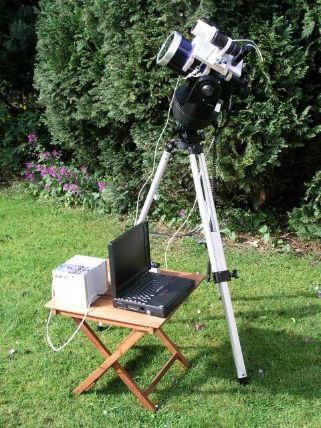
This is my ETX125 with the SLR lens piggybacked on the top. This is how I was set up to image the
transit of Mercury on 7th May 2003 (see my Mercury page for my results).
The piggyback is rather too heavy, and I have no counterbalance weights, but the drive has survived so far.
Essentially this is my set up for imaging the Sun (see my Sun page
for how to do this safely), except that I have the laptop in a cardboard box otherwise I can't see the screen.
The ETX is fitted with a Thousand Islands, glass solar filter; the SLR lens is protected by a home-made filter
built using a fitting for a drain pipe (which happened to fit my lens perfectly) and Baader solar film.
The white box behind the computer contains an 18-volt lead-acid battery which I use to run the computer. I
bought the laptop second-hand and its battery was not in good enough condition to run the computer with a web cam for
more than a few minutes. (Since then it has failed completely; I guess because I never used it.) The telescope
itself runs off a smaller, 12-volt lead-acid battery that can just be seen hiding behind the computer.
The telescope is polar mounted. During the daytime (and often at night too) I align the tripod using a compass,
and level it using the bubble-level built into the tripod. The head of the mount was adjusted using Polaris and has
not been touched since. This is generally adequate,
but the image does tend to drift upwards slowly but I can easily get a 2-minute AVI file without the object moving
off the top of the frame. This is as long as I need for anything I would use this telescope to image.
The telescope has an aperture of 125 mm and a focal length of 1900 mm. This is slightly greater than my refractor,
but it is only about a quarter of the length. The advantage of the Maksutov design over the Cassegrain is that the
secondary mirror is a reflecting patch on the back of the corrector plate. As such its alignment is built into the
telescope and never needs adjustment.
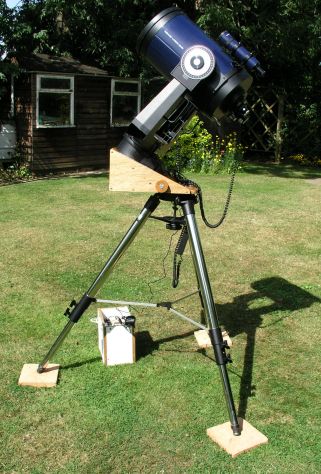
This is my LX200 Classic. It has an aperture of 254 mm (10 inches) and a focal length of 2500 mm (f/10).
I purchased it second-hand in 2003 and I think the previous owner looked after it well
so I was lucky to get it at a very reasonable price, which included five eyepieces. Its greater light-gathering power
make it much more suitable for nebulae, galaxies, and the like which tend to be quite faint. Also the stability of
its mount and the high quality of its drive system make it suitable for long-exposure imaging. It is a Schmidt-Cassegrain,
which is similar to the Schmidt-Maksutov, but the secondary mirror is separate from the corrector plate and can get
out of alignment. So it is necessary to check this frequently if the best images are to be made.
It is also much heavier than the ETX.
I find that the tripod is steadier when stood on the tiles. Grass is a little springy (except in the summer when it is
backed dry) and the tiles spread the load of the legs. I run the telescope off a car battery in the white wooden box,
which is fitted with fuses and two output sockets. One socket connects to a 12-18 volt converter (designed for running
a laptop from a car battery); the second provides power to the cooler on the camera.
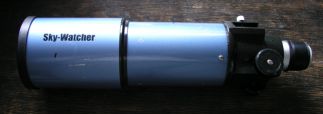
This is my ST80 Refractor.
I purchased it second-hand in December 2005 and I think the previous owner looked after it better than I have. I bought it to act as a guide-scope and mounted it piggy-back on my LX200 and the support screws have scratched the case.
It has an aperture of 80 mm and a focal length of 400 mm (f/5) which fits in well with my collection as the LX200 with a 0.33 focal reducer has a focal length of 800 mm, so this one gives me about twice the field of view which is useful for some of the larger objects in the sky (see M42).
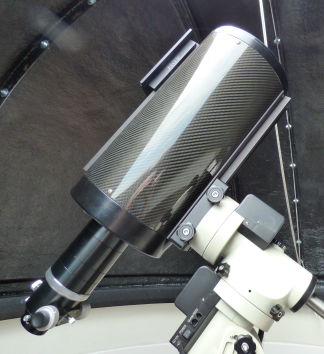
This is my 8-inch Revelation Ritchey-Chrétien reflector.
I was lucky to be able to purchase it in January 2015 as an ex-demo unit at a little over half its normal price. (But I had to wait whilst my garden was remodelled and my new observatory was built before I could begin to use it.) It is the carbon-fibre version which is significantly lighter than the metal version. The focal length is 1600mm (f/8) and the focal point of the system is about 26 cm behind the rear surface of the OTA so that for a simple camera all three of the supplied extension tubes have to be fitted before the Crayford-style focuser. With such a light optical tube, this results in almost all the weight being right at the back. Balance on a German Equatorial mount is normally achieved by sliding the OTA forward or back in the saddle that clamps it to the mount. I found that with this telescope balance was achieved with the rear of the dovetail bar about 2 cm forward of the rear of the saddle clamp. Although I think it was quite secure, nevertheless I felt it was undesirable. I had settled on Losmondy dovetails to mount my LX200 on this mount (see below) whereas the Revelation is fitted with Vixen bars. Consequently I had to get a Vixen-to-Losmondy converter if I was to fit my Losmondy-mounted accessories on the Revelation OTA. This adaptor is quite heavy and, placed near the front, it enabled me to slide the OTA back until the rear of the vixen dovetail was level with the rear of the saddle clamp. In the picture you can see this adaptor on top of the OTA .
On delivery the collimation was very bad and I had to completely recollimate it.
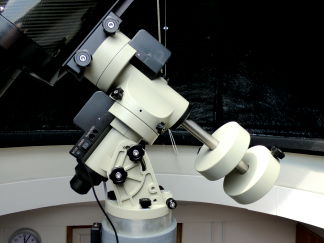
Purchasing the Revelation telescope presented me with the problem of how to mount it. Light as it is, it is a bit heavy to mount on top of my LX200, so I needed a new mount to take both my RCT and my SCT (but not together). After looking at the specs of several contenders, I selected the iOptron iEQ45 Pro. It is strong enough to hold the 14-kg LX200 and has probably the best specification in its price range. Here it is supporting my lighter RCT. In order to balance the heavier LX200 I had to buy the longer balance bar (see this picture). Even so the two 5-kg weights have to be at the far end of the bar before adding any extra weight to the LX200, so I have purchased an extra 5-kg weight. I had hoped this would enable me to remove the long bar but unfortunately it doesn't. The mount is fitted with a GPS unit so it knows exactly where it is, and a polarscope which enables good polar alignment quite easily. Altitude adjustment is well engineered, but there is an issue with the azimuth adjustment when mounted on a pier which I describe elsewhere.
It runs off 12 volts and no mains adaptor is provided in the UK—only a long cable with a car cigarette-lighter plug. I run mine off my 12-volt lead-acid battery. It is controlled by a hand controller with an 8-line display and all the features you might expect. GoTo a Target I find less convenient than the LX200 was but there is an enormous data base of objects.
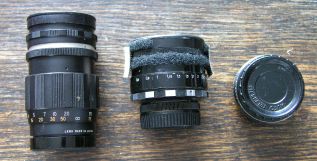
I also have a couple of SLR camera lenses and a X2 adaptor for them. The lenses have focal lengths of 135 (f/3.5) and 58 (f/2) mm, but both work better stopped down a little, so I normally use the 135-mm lens at f/5.6 and the 58-mm lens at f/4. I use the adaptor lens a great deal in place of a barlow lens, and my whole-Moon and whole-Sun images are taken with the 135-mm and the teleadaptor lens together which gives me 270 mm, usually at f/11.
Home Back to the Equipment